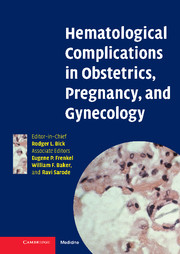Book contents
- Frontmatter
- Contents
- List of contributors
- Preface
- 1 Disseminated intravascular coagulation in obstetrics, pregnancy, and gynecology: Criteria for diagnosis and management
- 2 Recurrent miscarriage syndrome and infertility caused by blood coagulation protein/platelet defects
- 3 Von Willebrand disease and other bleeding disorders in obstetrics
- 4 Hemolytic disease of the fetus and newborn caused by ABO, Rhesus, and other blood group alloantibodies
- 5 Hereditary and acquired thrombophilia in pregnancy
- 6 Thromboprophylaxis and treatment of thrombosis in pregnancy
- 7 Diagnosis of deep vein thrombosis and pulmonary embolism in pregnancy
- 8 Hemorrhagic and thrombotic lesions of the placenta
- 9 Iron deficiency, folate, and vitamin B12 deficiency in pregnancy, obstetrics, and gynecology
- 10 Thrombosis prophylaxis and risk factors for thrombosis in gynecologic oncology
- 11 Low molecular weight heparins in pregnancy
- 12 Post partum hemorrhage: Prevention, diagnosis, and management
- 13 Hemoglobinopathies in pregnancy
- 14 Genetic counseling and prenatal diagnosis
- 15 Thrombocytopenia in pregnancy
- 16 Neonatal immune thrombocytopenias
- 17 The rational use of blood and its components in obstetrical and gynecological bleeding complications
- 18 Heparin-induced thrombocytopenia in pregnancy
- 19 Coagulation defects as a cause for menstrual disorders
- Index
- Plate section
- References
7 - Diagnosis of deep vein thrombosis and pulmonary embolism in pregnancy
Published online by Cambridge University Press: 01 February 2010
- Frontmatter
- Contents
- List of contributors
- Preface
- 1 Disseminated intravascular coagulation in obstetrics, pregnancy, and gynecology: Criteria for diagnosis and management
- 2 Recurrent miscarriage syndrome and infertility caused by blood coagulation protein/platelet defects
- 3 Von Willebrand disease and other bleeding disorders in obstetrics
- 4 Hemolytic disease of the fetus and newborn caused by ABO, Rhesus, and other blood group alloantibodies
- 5 Hereditary and acquired thrombophilia in pregnancy
- 6 Thromboprophylaxis and treatment of thrombosis in pregnancy
- 7 Diagnosis of deep vein thrombosis and pulmonary embolism in pregnancy
- 8 Hemorrhagic and thrombotic lesions of the placenta
- 9 Iron deficiency, folate, and vitamin B12 deficiency in pregnancy, obstetrics, and gynecology
- 10 Thrombosis prophylaxis and risk factors for thrombosis in gynecologic oncology
- 11 Low molecular weight heparins in pregnancy
- 12 Post partum hemorrhage: Prevention, diagnosis, and management
- 13 Hemoglobinopathies in pregnancy
- 14 Genetic counseling and prenatal diagnosis
- 15 Thrombocytopenia in pregnancy
- 16 Neonatal immune thrombocytopenias
- 17 The rational use of blood and its components in obstetrical and gynecological bleeding complications
- 18 Heparin-induced thrombocytopenia in pregnancy
- 19 Coagulation defects as a cause for menstrual disorders
- Index
- Plate section
- References
Summary
Venous thromboembolism (VTE) represents a major cause of morbidity and mortality during pregnancy, complicating from 0.5 to 3.0 of every 1000 pregnancies. Pulmonary embolism (PE) has been the leading cause of maternal mortality in the United States and Great Britain for at least 20 years and complicates approximately 1 in 1,000 pregnancies. This represents a VTE risk of 3–4 times greater than age-matched non-pregnant controls. Diagnosing venous thromboembolism is challenging because clinical findings are often misleading. When evaluated with objective testing, as many as 75% of patients suspected of having venous thromboembolism are found to have an alternative diagnosis. This poses an even greater problem in the pregnant patient who experiences vasodilatation and intravascular volume expansion (20–25% increase) with associated lower extremity edema. The accuracy of many diagnostic tests used in the non-pregnant patient are either not useful at all or are potentially misleading. Diagnosis of VTE is critical since 24% of pregnant women with untreated deep vein thrombosis (DVT) develop PE, with a death rate of 15% to 30%. Proper diagnosis and treatment reduces the mortality rate of PE to 1%–3%. In addition, postphlebitic syndrome in the affected leg occurs nearly 80% of the time following DVT in pregnancy, compared to 30–40% in the non-pregnant patient. Although it is well recognized that the incidence of PE is greatly reduced with treatment for deep vein thrombosis (DVT), treatment is also problematic since anticoagulation regimens used in the non-pregnant patient may be highly teratogenic or in other ways hazardous to mother and/or fetus.
- Type
- Chapter
- Information
- Publisher: Cambridge University PressPrint publication year: 2006



